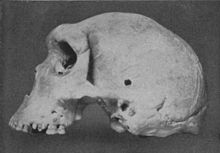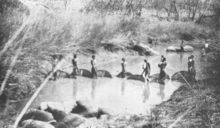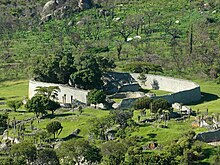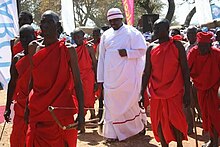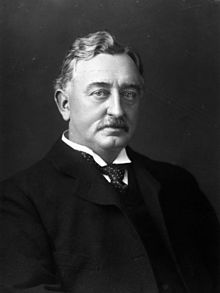History of Zambia
The fossil skull remains of Broken Hill Man, dated between 300,000 and 125,000 years BC, further shows that the area was inhabited by early humans.
The Bantu Expansion happened primarily through two routes: one was western via the Congo Basin and the other was eastern via the African Great Lakes.
Among them were the Tonga people (also called Ba-Tonga, "Ba-" meaning "men") and the Ba-Ila and other related groups who settled around Southern Zambia near Zimbabwe.
"[8]These early Bantu settlers also participated in the trade at the site Ingombe Ilede (which translate sleeping cow in Chi-Tonga because the fallen baobab tree appears to resembles a cow) in Southern Zambia, at this trading site they met numerous Kalanga/Shona traders from Great Zimbabwe and Swahili traders from the East African Swahili Coast.
Ingombe Ilede was one of the most important trading posts for rulers of Great Zimbabwe, others being the Swahili port cities like of Sofala.
Some of these items came from what is today southern Democratic Republic of Congo and Kilwa Kisiwani while others as far away as India, China and the Arab World.
[10] The decline of Great Zimbabwe, due to increasing trade competition from other Kalanga/Shona kingdoms like Khami and Mutapa, spelt the end of Ingombe Ilede.
As a result, they grew a diverse economy trading fish, copper and iron items, and salt for goods from other parts of Africa like the Swahili Coast and, later on, the Portuguese.
Nkongolo Mwamba symbolizes the embodiment of tyranny, whereas Mbidi Kiluwe remains the admired caring and compassionate kin.
With ruler Mwaant Yaav Naweej had established trade routes to the Atlantic coast and initiated direct contact with European traders eager for slaves and forest products and controlling the regional copper trade, and settlements around Lake Mweru regulated commerce from the East African coast.
[15] This instability caused the collapse of the Luba-Lunda States and a dispersal of people into various parts of Zambia from the Democratic Republic of the Congo.
This chaos gave the Portuguese the excuse they were searching for to warrant an attack on the kingdom and try to control its gold mines and ivory routes.
[21]It is hypothesised by Julian Cobbing that the presence of early Europeans slave trading and attempts to control resources in various parts of Bantu Speaking Africa caused the gradual militarization of the people in the region.
[23] This caused mass displacements, wars and raids throughout Southern, Central and Eastern Africa as Nguni or Ngoni tribes made their way throughout the region and is referred to as the Mfecane.
In 1888, Cecil Rhodes who was spearheading British commercial and political interests in Central Africa, obtained a mineral rights concessions from local chiefs.
In the beginning, the territory was administered by Rhodes' British South Africa Company (BSAC), which showed little interest in the province and used it mainly as a source of labour.
The discovery of which is due partly to an American scout, Frederick Russell Burnham, who in 1895 led and oversaw the massive Northern Territories (BSA) Exploration Co. expedition which established that major copper deposits existed in Central Africa.
At the core of the controversy were insistent African demands for greater participation in government and European fears of losing political control.
The council passed resolutions calling for Northern Rhodesia's secession from the federation and demanding full internal self-b under a new constitution, and a new national assembly based on a broader, more democratic franchise.
The constitution framed a system called "one-party participatory democracy", which in practice, meant that UNIP became the sole political factor in the country.
Simon Kapwepwe and Harry Nkumbula challenged the resultant 1978 election of President Kaunda in the High Court, but unsurprisingly their action was unsuccessful.
[41] To deal with the crisis, Zambia took big loans from the International Monetary Fund and the Worldbank hoping that copper prices would rise again soon, instead of issuing structural reforms.
[44] Conflicts with Rhodesia resulted in the closing of Zambia's borders with that country and severe problems with international transport and power supply.
However, the Kariba hydroelectric station on the Zambezi River provided sufficient capacity to satisfy the country's requirements for electricity.
They were generally regarded to have been free and fair, and Chiluba won 76% of the presidential vote, and the MMD 125 of the 150 seats in the National Assembly, with UNIP taking the remaining 25.
With support from the International Monetary Fund and World Bank, to which Zambia was heavily indebted, he liberalised the economy by restricting government interference, re-privatising state-owned enterprises, such as the important copper mining industry, and removing subsidies on various commodities, most notably on corn meal.
Questionable amendments of the constitution and detentions of political opponents caused major criticism, and some donor countries, i.e., the United Kingdom and Denmark, withdrew their aid.
Kenneth Kaunda had earlier retired from politics, but after internal turbulence in the party due to the "Zero Option Plan" scandal, he returned, replacing his own successor Kebby Musokotwane.
On 28 October a coup d'état attempt took place, as a group of army commanders took control over the national radio station, broadcasting a message stating that Chiluba was no longer president.
[57] In August 2021 presidential election, opposition leader Hakainde Hichilema defeated the incumbent, President Edgar Lungu, by a landslide.
